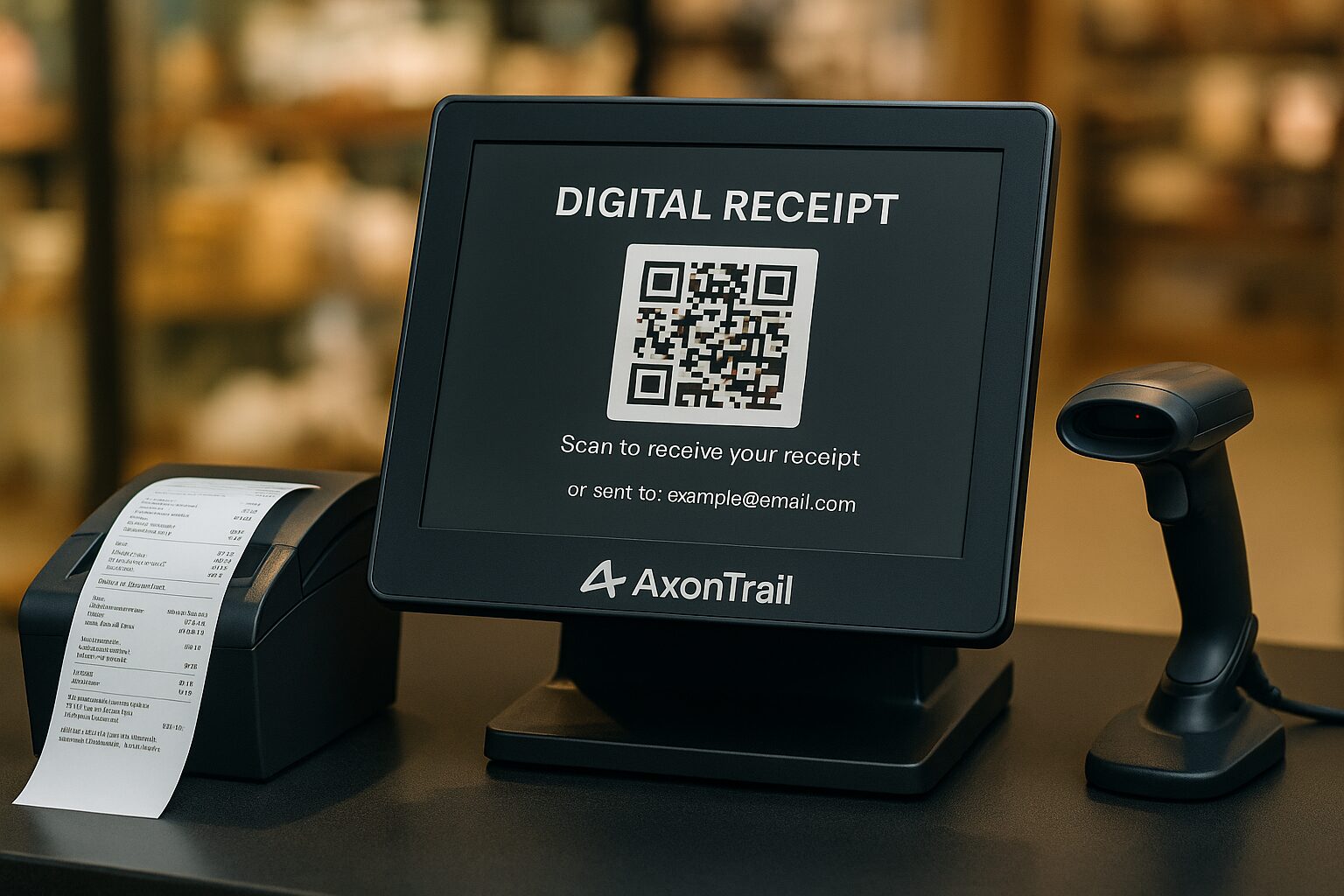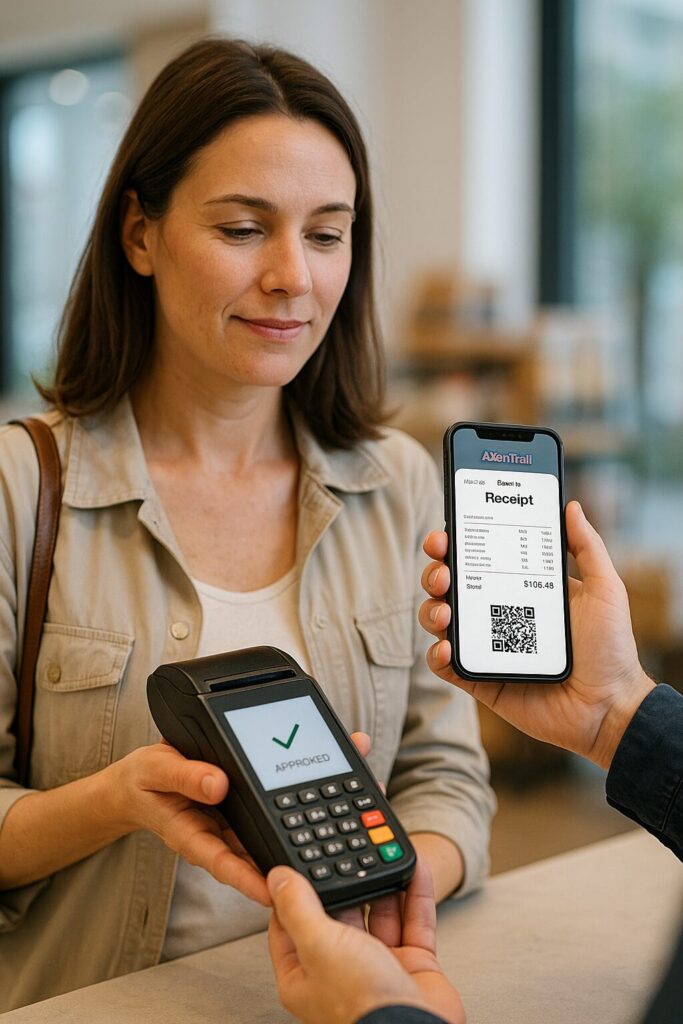
- September 3, 2025
- AxonTrail Editorial Team
- 0
For decades, the sound of a printed bill being torn from a cash register was the final step of a shopping experience in India. Whether at a roadside kirana store, a high-street apparel outlet, or a modern supermarket, the paper bill served as proof of purchase, warranty documentation, and a sense of completion for the transaction. But times are changing.
As we step into 2025, the retail industry is undergoing rapid digital transformation. One of the most visible changes lies in how customers receive receipts. The debate of Digital Receipts vs Printed Bills is not just about paper versus pixels; it’s about customer experience, cost efficiency, sustainability, and the role of technology in shaping retail.
This blog explores what customers truly prefer, why digital receipts are gaining momentum, the challenges of adoption, and how solutions like AxonTrail are enabling retailers to embrace the future of billing.
1. The Evolution of Retail Receipts
Receipts have always been an important part of retail. In the past, printed bills served as:
Proof of purchase
Warranty claim records
Tax and accounting documentation
A sense of assurance for customers
But with the rise of digitalisation, retailers and customers began exploring alternatives. SMS receipts, email invoices, QR-based digital bills, and app-based e-receipts entered the market. The shift accelerated during the pandemic when touchless transactions became a necessity.
Now, in 2025, the conversation of Digital Receipts vs Printed Bills reflects not just a preference but also a larger cultural and environmental shift.
2. Why Digital Receipts Are Winning Hearts
a) Convenience for Customers
Customers no longer want to carry bundles of paper bills in their wallets. Digital receipts are stored automatically in emails, SMS, or mobile apps. They can be searched and retrieved instantly.
b) Eco-Friendly Appeal
India generates millions of tonnes of paper waste annually. Digital receipts save paper, ink, and energy used in printing. Environmentally conscious customers increasingly prefer brands that support sustainability.
c) Integration with Personal Finance
Digital bills can integrate directly with expense tracking apps, making budgeting easier. This is especially popular among millennials and Gen Z professionals.
d) Reduced Errors
Printed bills are prone to smudges, fading, or misprints. Digital receipts are clearer, error-free, and come with proper formatting.
These are strong reasons why, in the Digital Receipts vs Printed Bills debate, customers are tilting towards digital options.
3. Why Some Customers Still Prefer Printed Bills
Despite the clear advantages of digital receipts, printed bills have not disappeared. Many customers still prefer them because:
Older generations trust paper more than digital.
Warranty and repair services in some industries still insist on paper copies.
Customers in rural or semi-urban areas may lack access to smartphones or email.
Thus, in the Digital Receipts vs Printed Bills discussion, printed receipts remain relevant for inclusivity and accessibility.
4. The Cost Factor for Retailers
From the retailer’s perspective, printed bills incur costs:
Paper rolls
Printing machines
Maintenance
Labour in handling storage and manual documentation
Digital receipts reduce these costs significantly. With QR-based digital invoices or automated email systems, retailers can cut operational expenses. Over time, this difference is why many businesses prefer digital billing solutions.
5. The Role of Sustainability
Sustainability is no longer a buzzword—it’s a business necessity. Customers are increasingly aware of how their choices impact the environment. Brands that encourage paperless billing are seen as eco-friendly, progressive, and socially responsible.
In the debate of Digital Receipts vs Printed Bills, sustainability is a key factor influencing younger, urban, and environmentally conscious customers.
6. Customer Behaviour in 2025: Insights and Trends
Surveys and industry studies in India show:
62% of urban customers prefer digital receipts over paper.
25% still prefer printed bills due to habit or necessity.
13% use both, depending on the type of purchase.
These numbers highlight that while digital receipts are rising, printed bills still have their space. The real solution lies in hybrid flexibility—offering both options and letting the customer choose.

7. How AxonTrail Simplifies Digital Billing
This is where AxonTrail Solutions comes in. As a cloud-based, AI-powered retail business solution, AxonTrail empowers retailers to embrace digital billing without complexity.
AxonTrail’s advantages:
Seamless Digital Billing: Generate receipts via email, SMS, or QR instantly.
GST Compliance: Automated e-invoicing aligned with Indian taxation rules.
Customer Choice: Offer both digital and printed receipts within the same system.
Data Insights: Track which receipt option customers prefer and adapt strategies.
Eco-Friendly Branding: Showcase your business as sustainable by reducing paper usage.
AxonTrail proves that the question is not about Digital Receipts vs Printed Bills alone—it’s about giving businesses the tools to offer flexibility, compliance, and efficiency.
8. Addressing Security Concerns
One concern customers have with digital receipts is security. People worry about data misuse, spam, or fraud. AxonTrail addresses this by:
Using encrypted communication for emails and SMS
Allowing customers to opt-in or opt-out
Ensuring GDPR and Indian IT compliance
Thus, AxonTrail ensures that digital adoption is not just convenient but also secure.
9. The Future Beyond 2025
Looking beyond 2025, the next wave of retail receipts will involve:
Integration with digital wallets (Google Pay, Paytm, PhonePe)
Smart receipts linked with loyalty points
AI-driven personalised offers within receipts
Cloud storage for lifetime access
In such a future, the debate of Digital Receipts vs Printed Bills 2025 will become less relevant, as customers will naturally move towards seamless digital-first systems.
10. Conclusion
The battle of Digital Receipts vs Printed Bills highlights the tension between tradition and innovation. While many customers embrace digital convenience, printed bills remain essential for inclusivity and trust.
The real winner is not one over the other—it is the retailer who offers choice and flexibility. By adopting solutions like AxonTrail, Indian businesses can meet diverse customer preferences, cut costs, remain compliant, and build sustainable growth.
The debate around Digital Receipts vs Printed Bills is more than just a difference in format—it reflects the changing relationship between customers and retailers. Digital receipts give shoppers instant access to their purchase history, warranty records, and loyalty points, eliminating the common frustrations of faded or misplaced paper bills. Printed bills, however, still hold a sense of reassurance for many, especially in smaller towns and traditional markets where physical proof is considered more trustworthy. This makes the ongoing conversation of Digital Receipts vs Printed Bills central to shaping the future of retail in India.
For retailers, the smartest move is to offer both choices. The flexibility of Digital Receipts vs Printed Bills allows businesses to serve tech-savvy customers who prefer paperless convenience while continuing to support those who still rely on physical receipts. With smart billing platforms like AxonTrail, retailers can provide digital receipts in seconds, stay GST-compliant, and still generate printed copies when needed. In practice, the balance between Digital Receipts vs Printed Bills isn’t about replacing one with the other—it’s about creating a customer-first model that blends efficiency, sustainability, and trust.
In 2025 and beyond, digital is no longer optional—it is the backbone of smart retail.
FAQs on Digital Receipts vs Printed Bills
Q1. What is the main difference between digital receipts and printed bills?
Digital receipts are delivered electronically via email, SMS, or apps, while printed bills are physical paper copies.
Q2. Why are digital receipts preferred in 2025?
Because they are convenient, eco-friendly, cost-saving, and integrate easily with personal finance tools.
Q3. Are printed bills still relevant in 2025?
Yes, they remain relevant for customers who trust paper, especially in rural areas or for warranty claims.
Q4. How do digital receipts support sustainability?
They reduce paper usage, saving trees, energy, and waste—making retail more eco-friendly.
Q5. How does AxonTrail support digital receipts?
AxonTrail provides cloud-based billing solutions that generate digital receipts instantly while maintaining GST compliance.
Q6. Are digital receipts safe?
Yes, if encrypted and managed through trusted platforms like AxonTrail, digital receipts are secure.
Q7. Do customers have a choice between digital and printed bills?
Yes, modern systems like AxonTrail allow businesses to offer both options based on customer preference.
Q8. Will printed bills disappear completely?
Not immediately—printed bills will remain for certain segments, but their usage will decline over time.
Q9. What industries benefit most from digital receipts?
Retail, restaurants, supermarkets, healthcare, and service industries benefit greatly from faster digital billing.
Q10. Why should retailers switch to digital receipts in 2025?
Because digital receipts enhance customer experience, cut costs, and future-proof businesses.
